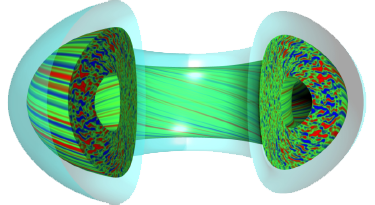Speaker
Description
Reduced models of SOLPS-ITER plasma edge simulations are deployed in the time-dependent model predictive control of upstream and downstream divertor conditions. Virtual main ion and impurity gas puffs actuate the simulated tokamak boundary based on predictions obtained from the dynamic mode decomposition (DMD) and the Sparse Identification of Nonlinear Dynamics (SINDy) data-driven techniques. Equations governing the time evolution of the plasma state are extracted from an expansive database of transport runs configured to the DIII-D experiment and mediated by actuation sequences probing system response. An automated algorithm is developed to scan a running series of simulation data that enables training and testing of reduced models capable of a prediction horizon within a cross-validated error threshold. With the computationally inexpensive DMD and SINDy procedures, an offline evaluation of model predictive control of the expensive SOLPS-ITER code is presented. The optimal actuation sequence required to produce a target trajectory, subject to physical constraints on the input and output signals, is determined for static and variable setpoints. Baseline feedforward control with gas puff actuators has been found to agree well with the dynamics of the upstream separatrix density and modifications to DMD and SINDy have allowed adequate control of the noisy downstream divertor target temperature. The data-driven approach to model predictive control described in the paper is being implemented as a module that can be utilized within SOLPS-ITER in an online manner for performing simulations. In addition, the results are being validated against analytic and empirical correlations of key observables from experiments for application to future device designs.
Work supported by US DOE under contract numbers DE-AC05-00OR22725 and DE-FC02-04ER54698.
| Country or International Organisation | United States of America |
|---|---|
| Affiliation | Oak Ridge National Laboratory |

